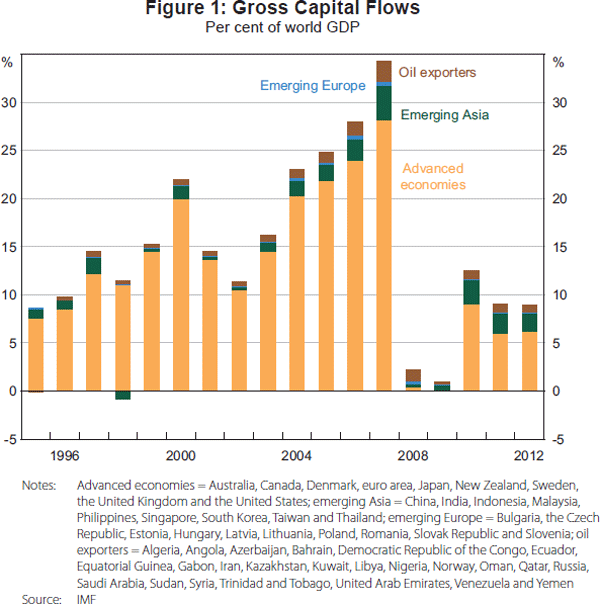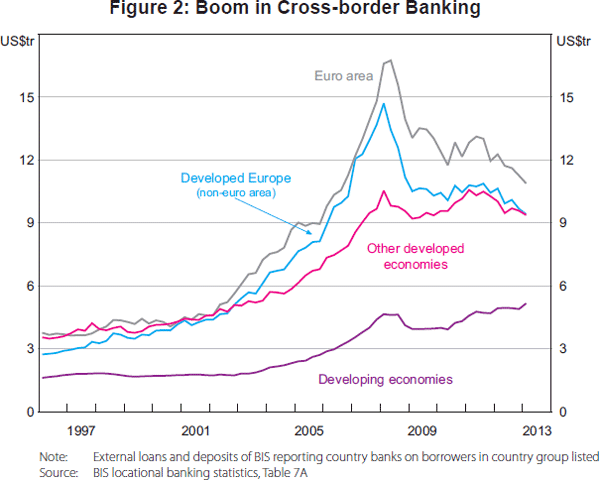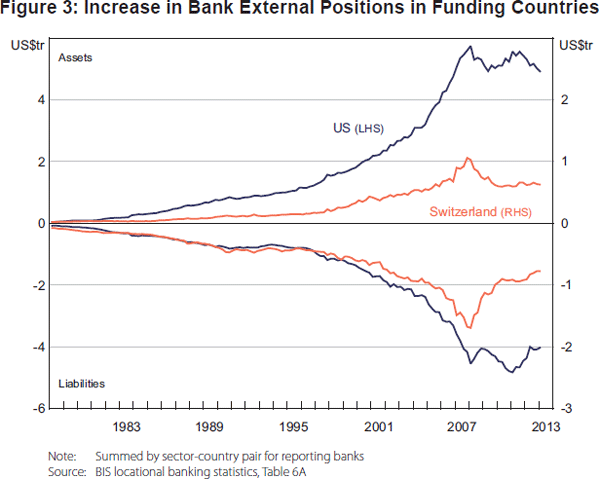RBA Annual Conference – 2013 Discussion
1. Piti Disyatat
Let me begin by noting two striking observations. First, in the decade leading up to the global financial crisis, there was an enormous expansion in gross capital flows (Figure 1). At the peak in 2007, the sum of gross inflows and outflows amounted to as much as 35 per cent of world GDP. This compares with net flows (i.e. current accounts) that, when summed up across economies, make up at most around 3–4 per cent of world GDP.

The bulk of this explosion in gross flows is due to cross-border trades in financial instruments. For example, consider the case of an Australian bank that issues a US dollar bond offshore to non-residents. On the one hand, non-resident claims on Australia increase: thus there is a gross inflow into Australia. On the other hand, the Australian bank has acquired US dollars, which is a claim on non-residents: thus there is a gross outflow. Hence, financial transactions such as these typically involve two-way gross flows. Notice that the current account and net capital flows are unaffected in all this. Looking at developments in gross flows is much more informative about cross-border financial flows and intermediation than focusing on net flows (see Borio and Disyatat (2011) for detailed discussion).
Second, the last decade has also witnessed a large boom in cross-border banking. This is illustrated in Figure 2 which plots the external claims of BIS reporting country banks on borrowers in different regions. The run-up was particularly large in advanced economies, especially among countries in the euro area, though developing economies also saw persistent uptrends in such flows. These flows have become an increasingly important component of gross capital flows and have large financial stability implications.

What I like very much about Miranda Agrippino's and Rey's paper is the focus on gross capital flows and on banking flows.
The overall goal of the paper is to study the link between cross-border banking flows, global risk, credit and asset prices in carry-trade recipient economies. The analysis is carried out in three separate parts that seek to investigate: (i) the determinants of banking inflows; (ii) the impact of inflows on property prices; and (iii) the dynamic response of domestic and external credit to interest rate, exchange rate and VIX shocks.
The analysis is done well and I have no major issues with the estimation or the results, which are largely in line with previous studies (see, for example, Bruno and Shin (2013)). My comments will focus largely on two issues: (i) the heavy emphasis on carry trades as the key motivation for the paper; and (ii) the lack of a clear description of the underlying transmission mechanism between capital inflows and domestic credit expansion.
The carry-trade focus
A key motivation for the paper is to study the impact of capital inflows in carry-trade recipient countries. The authors use the criterion of ‘perceived’ carry-trade recipient as a basis for selecting the sample of countries in the study. The main problem with such an approach is that carry trades are notoriously hard to pin down. There are a number of ways to implement such trades and much of these involve the use of derivatives, which are off-balance sheet items (see, for example, Galati, Heath and McGuire (2007)). Moreover, carry trades are often indistinguishable from other flows. For example, a long Australian dollar/short Japanese yen carry trade is typically implemented by entering into a forward contract to buy Australian dollars against yen at some point in the future. Such a position is identical to one that would arise from an Australian exporter to Japan who wishes to hedge his anticipated Japanese yen export receipts back into Australian dollars.
The paper does not specify exactly what criteria are used to determine carry-trade recipient countries. Presumably high interest rates would be one key factor, but the question is relative to whom? And for a sample period of over 10 years it is hardly the case that such relative interest differentials will be stable. So a given country may be a carry-trade recipient in some periods and a funding currency in another. Indeed, in almost all of the specifications in the paper, interest differentials are not a significant determinant of capital inflows.
Moreover, there are formidable data shortcomings when it comes to identifying carry trades. The Bank for International Settlements (BIS) banking statistics used in the study only cover on-balance sheet positions. Hence, much of the carry-trade activity, which is typically implemented through the forward market, is not captured. It is also not possible to distinguish carry-trade positions from those arising from general borrowing and lending by firms and households. Finally, a carry trade specifically involves two currencies where the exposure to exchange rate risk is a key part of the strategy. As such, the analysis should strictly focus on non-resident claims on local currency only, as opposed to total claims as in the paper.
The upshot is that it is not quite clear what the country grouping, which in the sample includes disparate countries such as Canada, Iceland, Mexico and Norway, really represents. That said, the countries in the sample all did experience substantial banking inflows. In this respect, the paper would be improved if the carry-trade focus were downplayed and if it were motivated more generally as a study of the behaviour and impact of banking inflows in a set of countries where such inflows have been high.
Capital inflow and domestic credit
There is a recurring implicit assumption throughout the paper that banking inflows from abroad lead to an expansion of domestic credit. This is especially so in the VAR analysis, which attempts to go beyond the analysis of correlations in the first two sections of the paper to ascertain some direction of causation from banking inflows to domestic credit. While the results do seem to support this, it would be useful if the paper clearly laid out conceptually how such a link may work in practice. The main sticking point here is that there is no direct link between capital inflows (banking or otherwise) and domestic currency credit. In particular, capital inflows do not expand the supply of domestic currency funds available for lending.
The supply of domestic currency funds in terms of the deposit base in local currency is largely dictated by the pace at which domestic banks extend loans. As domestic banks extend loans, local currency deposits are created. Capital inflows simply entail the acquisition of such deposits from someone else. Local currency deposits simply change hands and the aggregate size is unchanged. Those deposits, of course, represent domestic purchasing power which can be used to buy local assets or extend loans. Thus capital inflows may enhance or lengthen the intermediation chain of domestic funds, but do not create new purchasing power. The influence that capital inflows have on domestic credit must be indirect, through their impact on relative yields and risk perceptions, rather than a direct relaxation of some quantitative constraint on lending capacity.
Of course, capital inflows can directly expand foreign currency credit. For this to materially affect domestic spending requires that a domestic resident be willing to undertake foreign exchange rate risk. While this has occurred in some countries, such as the central and eastern European countries, the substantial risks involved should limit the extent that this can, or is allowed to, take place.
Rather than viewing banking inflows as driving domestic credit as the paper does, one distinct possibility is that variations in banking inflows simply reflect the intermediation of domestic credit largely driven by variations in local economic prospects. The sustained expansion in cross-border banking flows in the lead-up to the financial crisis reflects a lengthening of the intermediation chain in many countries in an increasingly globalised financial system. Thus variation in banking flows is the ‘tail of the dog’, so to speak, largely dancing to the tune of changes in local credit expansion.
For example, take the case of Australia where domestic banks obtain around 30 per cent of their funding from abroad. When a loan is granted to a domestic resident, banks may seek to fund this through foreign borrowing. Alternatively, suppose a domestic resident wants to obtain foreign currency to finance direct investment abroad from a local bank. The domestic banking system may obtain the foreign currency by borrowing abroad (usually through the swap market). In both cases, there will be expansions in cross-border inflows that reflect the intermediation of credit and associated currency hedging activities. Ultimately, regardless of whether it is funded domestically or internationally, the extension of domestic bank credit is a decision of domestic banks based on local needs.
More generally, the direction of causality of the global factor highlighted in the paper deserves further scrutiny. The importance of the VIX in explaining capital flows is certainly striking. This has also been documented in numerous studies. The paper interprets this as indicating an important role for global factors in driving capital inflows. The image is one of an ‘ocean of liquidity’ being pushed into countries driven by variations in the VIX. The question is what the VIX really represents. After all, the investor sentiment that it captures is endogenous and closely related to real economic developments. One possibility is that variations in the VIX proxy for incoming news about the state of the global economy, which obviously has important ramifications for the domestic economies of various jurisdictions. This, in turn, may lead to changes in local credit demand and supply. The related changes in banking inflows then simply reflect the changes in cross-border intermediation associated with this. That is, the ebb and flow of cross-border banking is a reflection of variations in local credit extension rather than being their driver.
Figure 3 shows, for example, that even for countries typically associated with ‘funding currencies’ in carry-trade activity, there is substantial banking inflow. These largely mirror outflows. An examination of recipient countries also reveals the two-way nature of capital flows that reflect the cross-border intermediation function of banks. As such, it is quite difficult to disentangle the chicken from the egg and get a clear picture of causality.

The key issue at stake here ultimately is how policy should respond. If capital inflows are seen as driving domestic credit, then one might be inclined to argue for some sort of control to be put in place to alleviate perceived negative effects, not least the complications that they pose for monetary policy. On the other hand, if the ebbs and flows of cross-border banking reflect the intermediation of domestic credit that is largely driven by local economic conditions and needs, then it is not clear that they should be seen as something that must be limited. Ultimately, it is difficult to answer such questions without some views about the appropriate funding model of banks. Should they be predominantly deposit based or does wholesale funding offer worthwhile efficiency gains? The paper is largely silent on these issues.
References
Borio C and P Disyatat (2011), ‘Global Imbalances and the Financial Crisis: Link or No Link?’, BIS Working Papers No 346.
Bruno V and HS Shin (2013), ‘Capital Flows, Cross-Border Banking and Global Liquidity’, Princeton University, Griswold Center for Economic Policy Studies Working Paper No 237a.
Galati G, A Heath and P McGuire (2007), ‘Evidence of Carry Trade Activity’, BIS Quarterly Review, September, pp 27–41.
2. General Discussion
The discussion of the paper presented by Hélène Rey began with several comments about its framing and interpretation. In response to comments by Piti Disyatat in his discussion, Professor Rey confirmed that the VIX was certainly not exogenous. Rather, she stated that other studies that used either a recursive VAR or structural VAR framework found that the effects of the VIX on capital flows and asset prices were attributable to the US federal funds rate. Another participant asked whether other volatility measures might be better explanators of capital flows. Professor Rey responded that she planned to test this, but given the high degree of correlation across different volatility measures, she suspected any candidate measures would be strongly correlated with the VIX and therefore unlikely to provide much further insight.
The precise nature of the carry trade, and its relationship to volatility, was raised by several participants. A number of participants suggested that the pre-2007 carry trade followed a classic interest rate differential motive, for example private Japanese investors taking Australian and New Zealand bond risk and transacting in basis swaps with banks, that had little intuitive relationship with the VIX. This was contrasted against the risk-on/risk-off environment that had characterised financial markets since the start of the financial crisis. In particular, over this period the role of the VIX had been clearer, with a high correlation across many asset prices, including the Australian and New Zealand dollar exchange rates and the S&P 500. It was also suggested that current cross-border financial flows were primarily the result of balance sheet expansion as a side effect of unconventional monetary policy, rather than a response to prices in the form of interest rate differentials. Several participants expressed their surprise that the VIX mattered at all in the pre-financial crisis period, with one questioning why the VIX would matter given that the carry trade prior to 2007 primarily used yen as a funding currency and did not involve the US dollar. Another noted that the relationship between risk and the Australian dollar had been unstable over recent years; notable appreciations and depreciations had both occurred in risk-off periods, suggesting that the motivation for capital flows were broader than the carry trade alone. In response, Professor Rey noted that the term ‘carry trade’ was meant loosely, both because only a subset of countries in the paper's sample were typical carry trade economies, and because the analysis of the paper was more general than this specific yield-seeking activity. She suggested that the VIX could be relevant, despite transactions not necessarily being denominated in US dollars, because of the importance of the US dollar and the federal funds rate in affecting leverage of financial intermediaries in the global banking system. She noted this had echoes of the Calvo, Leiderman and Reinhart (1996) result that capital inflows to Latin America were associated with weak global economic conditions and low interest rates.
Another participant asked if splitting the sample group of countries according to different characteristics, such as the degree of exchange rate flexibility, would demonstrate varying sensitivities of capital flows to the VIX. They suggested that while the underlying economic arguments were unaffected, it seemed plausible that volatility of capital flows increased with flexibility of the exchange rate and ease of transacting in the currency because investment managers would be able to take manageable cross-border risk more effectively. Professor Rey agreed that looking at financially sophisticated countries in more detail was worthwhile because the exchange rate played an important role.
Picking up on comments made by the discussant, one participant asserted that global banks were very important intermediaries for small open economies, and it was imperative that regulation aimed at producing better long-run outcomes in financial markets did not undermine this role. They noted that local banks in periphery jurisdictions tended to have substantial directional positions, so global banks were needed to take the other side of these positions, effectively providing financial intermediary services to economies such as Australia and New Zealand. While this intermediation led to an increase in banking flows, this was not necessarily a negative outcome.
Reference
Calvo GA, L Leiderman and CM Reinhart (1996), ‘Inflows of Capital to Developing Countries in the 1990s’, The Journal of Economic Perspectives, 10(2), pp 123–139.